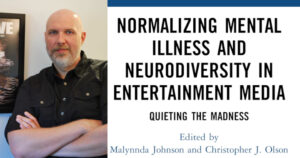Christopher Olson has coped with anxiety and depression his entire life. One day, he watched an episode of the Netflix series “BoJack Horseman,” an animated show about an alcoholic former television star navigating Hollywood. In that episode, the audience hears the titular character’s inner monologue (be warned, the linked video contains profanity), complete with frenetic scribbled animation.
“As I was watching that episode, I was like, how did they get into my head? That’s the litany that ran through my head for years,” Olson said.
That, he noted, was the driving reason he wanted to make his newly-published book , “Normalizing Mental Illness and Neurodiversity in Media: Quieting the Madness.”
Olson is working toward his PhD in media studies at UWM. He’s authored, co-authored, and co-edited several books focusing on topics like cult movies and television shows and professional wrestling, but this book is a bit more academic than his previous work.
“(Co-editor Malynda Johnson and I) noticed … the preponderance of shows and movies and other media that are starting to very frankly deal with the issues of neurodiversity and mental health,” Olson said. “I was like, we need to do something with this. This is a topic that I think people need to dig into and talk about.”
Others agreed; Olson and Johnson’s book garnered an Honorable Mention award in the Best Edited category at the Midwest Popular Culture Association’s book awards ceremony in October.
A book is born
Olson met Johnson, an assistant professor of communication at Indiana State University, at a conference hosted by the Midwest Popular Culture Association a few years ago. After the two discovered their mutual interest about mental health portrayals in media, they sent out a call for papers and approached the publisher Routledge with their idea.
Routledge bit and the papers flowed in. Olson and Johnson compiled them in a loose order: One grouping deals with the portrayal of therapy in shows like “Modern Family” and a children’s show called “The Loud House;” another examines eating disorders in media, and another focuses on neurodiversity.
Olson’s own essay in the book stemmed from his interest in professional wrestling, which he says often uses negative stereotypes as cultural shorthand.
“One of the main negative stereotypes that you see is the ‘crazy woman.’ She’s shrill and angry,” he noted. “But in recent years, a lot of professional wrestlers have been very open about their own struggles. There were two women who were very open about their eating disorders … on their reality show, ‘Total Divas.’ We thought, let’s look at what this ancillary program is doing and how that informs the characters that they play in the ring.”
More essays in the book focus on topics like posttraumatic stress disorder in the films “Taxi Driver” and “You Were Never Here,” or how Dory the fish’s short-term memory disorder impacts her relationships in the Pixar movies “Finding Nemo” and “Finding Dory.”
And Olson said, there are a more than a few UWM ties in the book. “(Co-editor) Malynda Johnson is a UWM alum. She got her PhD from UWM (’12, Communication). Then Ali (Gattoni, an assistant faculty associate in the UWM Communication Department) has a chapter in here.”
Mental health and media
If mental health and neurodiversity are becoming more accepted in mainstream pop culture these days, it was a long road to get there. For decades, Olson said, if movies or television shows dealt with mental illness, it was to characterize the villain.
“That’s one of the things that we talk about in the intro to the collection. For a long time, the dominant portrayal of mental illness was negative in media,” he added. “The villain was the mad scientist or the crazy jealous woman. Horror especially uses mental illness and neuroatypicality to position the ‘monster’ against ‘normal society.’”
That started to change around the turn of the millennium. People gradually became more open about the topic of mental illness, and movies and television soon followed. Then the advent of social media like Facebook, Instagram, YouTube, and now TikTok allowed people to begin sharing their mental health experiences with other people who faced similar issues.
The riseof streaming services played a role too, especially as companies like Netflix, Amazon, and Hulu began to make their own content.
“In the past, you would have network television where they’re trying to appeal to this broad audience, but with streaming, with their algorithms, they’re able to really target niche audiences,” Olson said. “So, for example, there was a show created by comedienne Maria Bamford called ‘Lady Dynamite’ that was on Netflix, about her own struggles with bipolar disorder and depression. … I think, as we’re seeing the further fragmentation of media into these more niche audiences, you’re seeing more people (saying), ‘I can speak about these things and I will get an audience of people who will watch it.’”
And it’s not just in movies and television. Comic books, video games, and other forms of entertainment have also begun to incorporate mental health in their storylines. Olson regrets that he and Johnson weren’t able to include those forms of media in the book.
But, he said, maybe they can add them in if there’s ever a Volume 2.
By Sarah Vickery, College of Letters & Science
